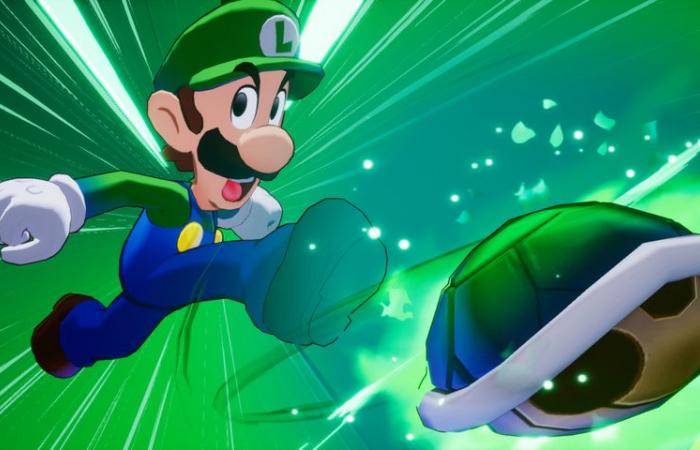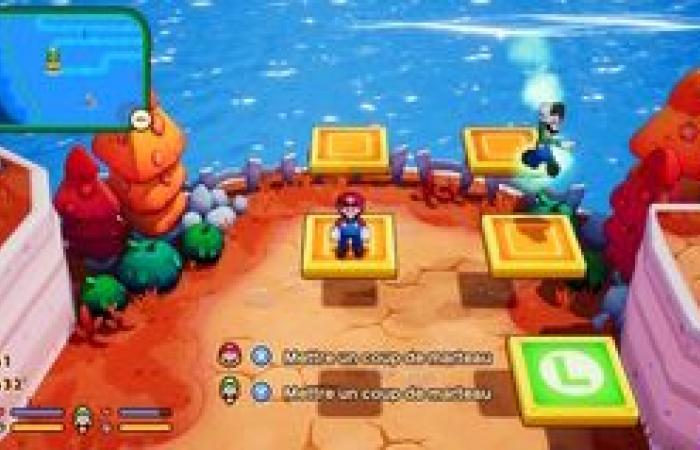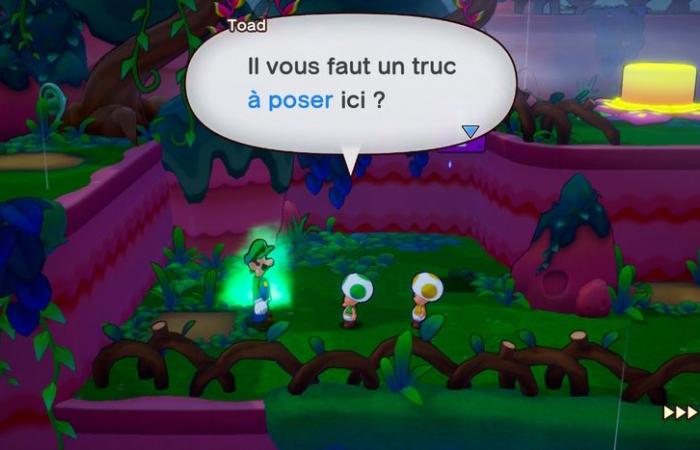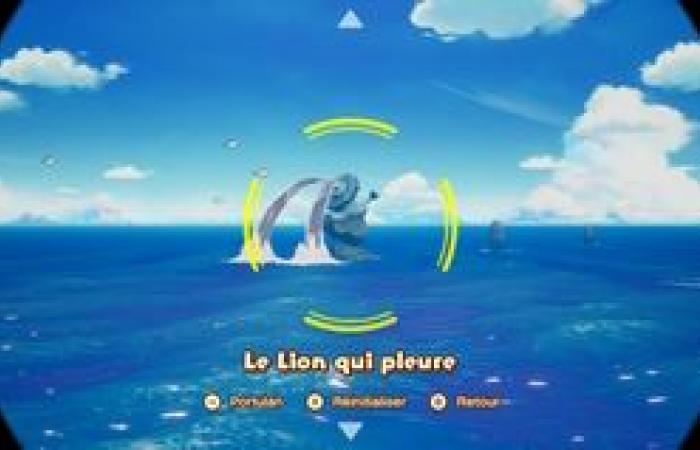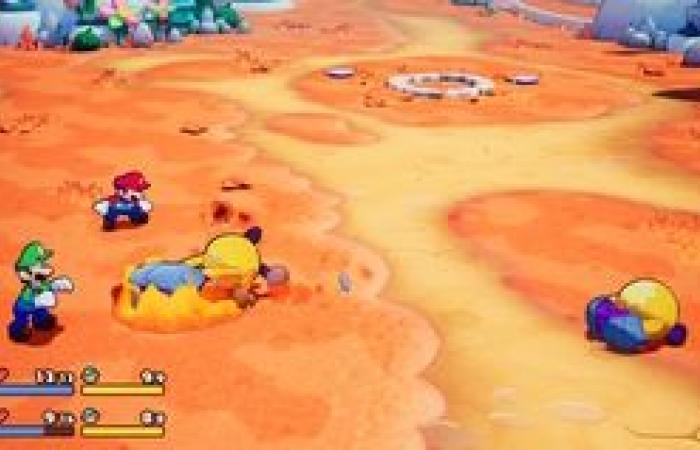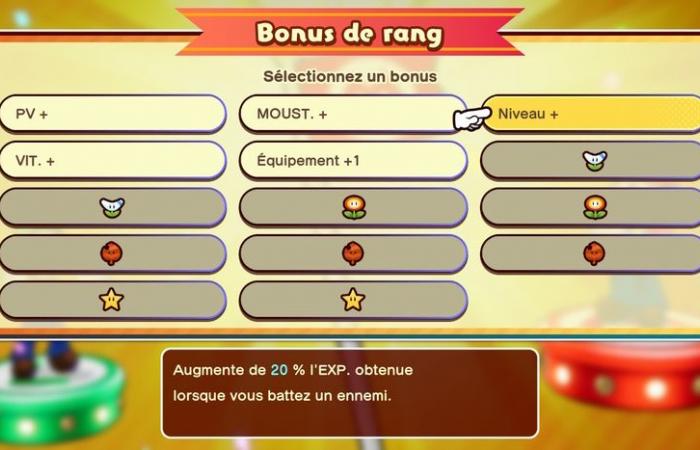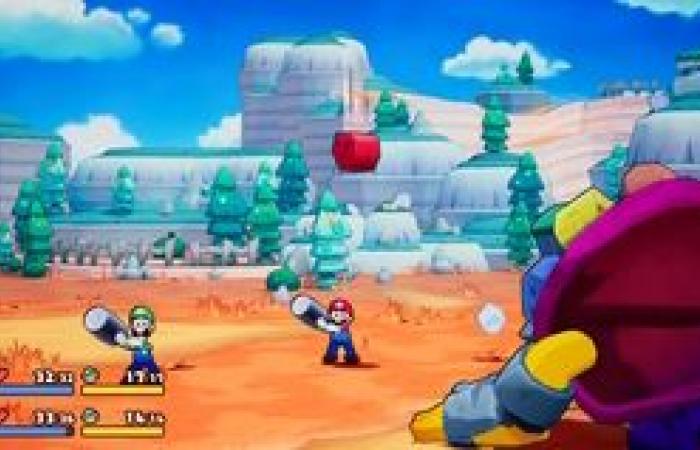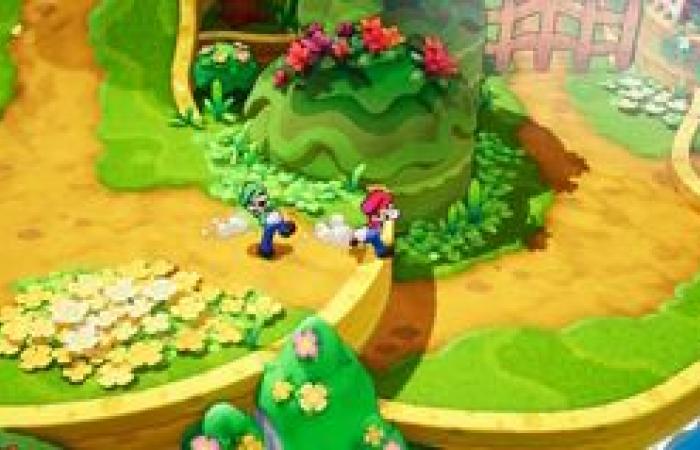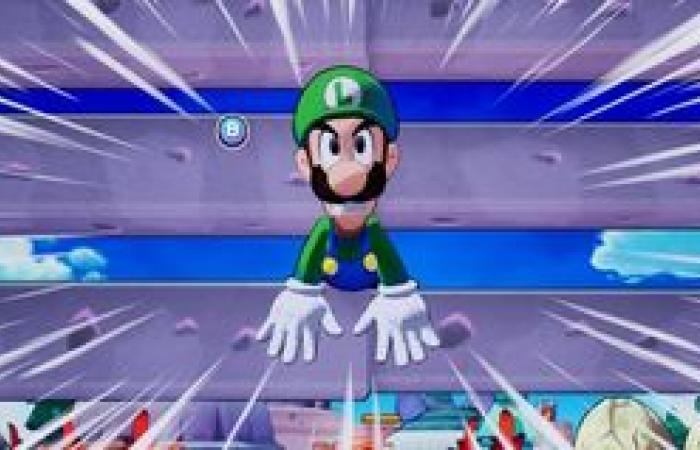Busy happily hanging out in the Mushroom Kingdom, Mario and Luigi are sucked into a strange magical whirlwind. Peach, Bowser and an army of Toads also find themselves catapulted into the parallel world of Connexia, ex-continents with shimmering colors which were fractured by an apocalyptic catastrophe. Connexia is nothing more than a scattered archipelago divided between several different seas, where the islands drift with the waves. Our objective is to work with Ampéria, a young “volticulturist”, to reconnect the islands and the people after this tragedy. Our heroes sail aboard the Navisthmus – a boat-shaped island capable of holding as many castaways as necessary – to connect the cities to the Unicea, a large magical tree capable of emitting empathic energy remarkably similar to electricity .
So much for the narrative context. Compared to its big brothers, Mario & Luigi: The Brotherly Epic is striking by the absolute poverty of his writing, which describes infernal repetitive spirals like a Saturday morning cartoon condemned to subsist in its the state in which. No significant antagonist to unravel, almost no valves that hit the mark, and above all, narrative arcs that one would hardly dare to print in a children's book as the writers of Acquire take the players for buzzards. To save Connexia, we must find four great lighthouses like so many electrical relays; our acolytes Ampéria and Archibald (a sailor drawn from the waves) will never stop repeating the importance of this quest, repeating the importance of the great lighthouses, their usefulness, their functioning… like so many summaries to verify that the player did not sleep during the last lecture.
It's quite simple, the last time someone held my hand this much, I had three years of toxic relationships. Mario & Luigi: The Brotherly Epic constantly interrupts the player by showing or explicitly describing the solution to the basic environmental puzzles that punctuate our progress. Furthermore, as soon as Luigi leaves the screen for reason Hence the feeling of being a baby stuck in his walker; to be stuck in a padded cell where all possible obstacles are padded to prevent injury. Each puzzle or secondary quest therefore boils down to limply following the instructions provided by the camera and the dialogues, when it is not simply a good old Fedex quest whose uselessness Final Fantasy 16 has recently perfected. Indeed, secondary quests generally offer one or two healing items that can easily be purchased in bulk in the various shops.
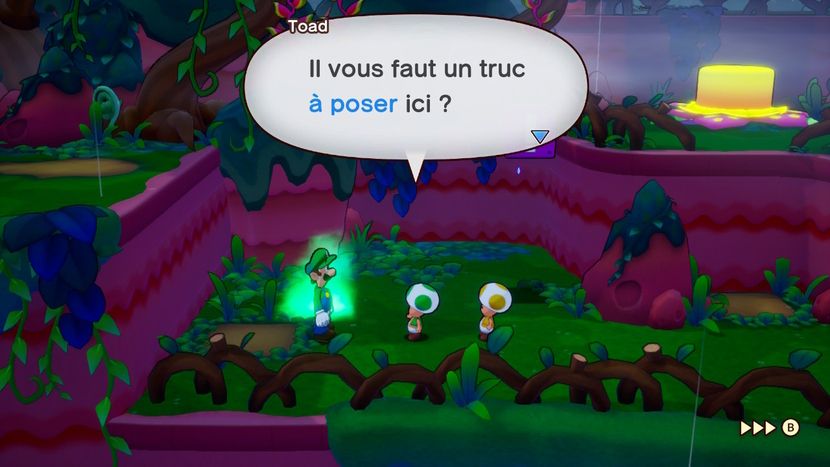
 Suffice to say that progress is quickly painful. Acquire divides the universe into different islands separated by specific currents, which we can take by boat to reach new lands. But this is still just an artifice. You have to wait for our boat to follow the waves to reach a new island, but you can activate the turbo to almost skip this phase; previously visited islands are easily found by fast travel; Finally, sailing serves no purpose other than passing time, since no random event can stop our cruise. Each island is oriented around a small gameplay mechanic, like Trampoflora's bouncing flowers, but the big limitations of level design mentioned previously keep the difficulty of the environmental puzzles at the level of the daisies. In fact, the player has the sensation of visiting a series of levels planned for a 3D platform game à la Super Mario Odyssey, which would have been hastily transformed into an RPG shoehorned in its last year of production. We just follow the planned order of the islands to reconnect everything in order, and ultimately, navigation is really just window dressing.
Suffice to say that progress is quickly painful. Acquire divides the universe into different islands separated by specific currents, which we can take by boat to reach new lands. But this is still just an artifice. You have to wait for our boat to follow the waves to reach a new island, but you can activate the turbo to almost skip this phase; previously visited islands are easily found by fast travel; Finally, sailing serves no purpose other than passing time, since no random event can stop our cruise. Each island is oriented around a small gameplay mechanic, like Trampoflora's bouncing flowers, but the big limitations of level design mentioned previously keep the difficulty of the environmental puzzles at the level of the daisies. In fact, the player has the sensation of visiting a series of levels planned for a 3D platform game à la Super Mario Odyssey, which would have been hastily transformed into an RPG shoehorned in its last year of production. We just follow the planned order of the islands to reconnect everything in order, and ultimately, navigation is really just window dressing.
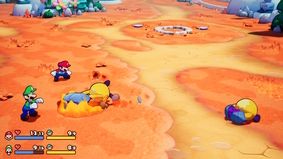 Mario & Luigi: The Brotherly Epic doesn't really have a red wire, just dangling electrical wires. If the story is based on reconnecting people with an electric aesthetic, with light bulb trees or jack-shaped antagonists, Acquire fails to find a real strong idea that unites everything in a convincing way. Certainly, as the title indicates, Mario and Luigi collaborate constantly. In turn-based combat, whether we decide to jump on an enemy or strike with a hammer (you have to choose intelligently depending on the opponent's guard), our two brothers combine their strength to make short work of each other. , in order to jump higher, or give a boost to the other's hammer. The fraternal epic also marks the return of “ brothers attacks “, which consume the equivalent of mana and can inflict critical damage on opponents provided they successfully complete an elementary rhythm mini-game.
Mario & Luigi: The Brotherly Epic doesn't really have a red wire, just dangling electrical wires. If the story is based on reconnecting people with an electric aesthetic, with light bulb trees or jack-shaped antagonists, Acquire fails to find a real strong idea that unites everything in a convincing way. Certainly, as the title indicates, Mario and Luigi collaborate constantly. In turn-based combat, whether we decide to jump on an enemy or strike with a hammer (you have to choose intelligently depending on the opponent's guard), our two brothers combine their strength to make short work of each other. , in order to jump higher, or give a boost to the other's hammer. The fraternal epic also marks the return of “ brothers attacks “, which consume the equivalent of mana and can inflict critical damage on opponents provided they successfully complete an elementary rhythm mini-game.
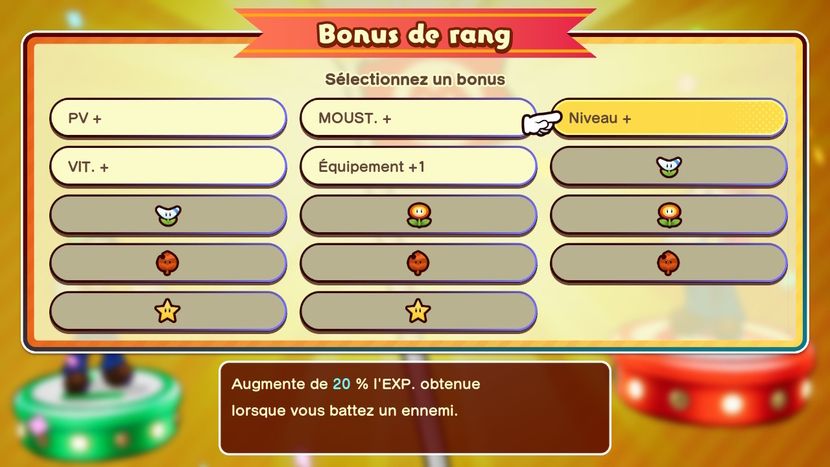
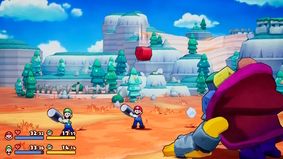 Mario and Luigi can dodge or counter enemy attacks using small QTEs that genuinely test our reflexes. And this is where the whole point of The fraternal epic. Despite the small number of options, each turn of the game requires reacting to enemy attacks. Each monster has several patterns, some of which are expressly designed to deceive us: hunting birds with extendable blows will be able to pretend to aim at Mario, while it is Luigi who will ultimately be attacked, and will have to repel the piaf with a mace. Learning the patterns turns out to be more difficult than expected, especially since the counterattack timings are sometimes tight. To minimize risks, our plumber comrades can use an emergency guard which reduces the damage suffered, and is expressly used to understand the opponent's mechanics before risking a counterattack. It's dynamic, fresh, pleasant, good-natured, even if enemy attacks are sometimes difficult to predict unless you have good reflexes.
Mario and Luigi can dodge or counter enemy attacks using small QTEs that genuinely test our reflexes. And this is where the whole point of The fraternal epic. Despite the small number of options, each turn of the game requires reacting to enemy attacks. Each monster has several patterns, some of which are expressly designed to deceive us: hunting birds with extendable blows will be able to pretend to aim at Mario, while it is Luigi who will ultimately be attacked, and will have to repel the piaf with a mace. Learning the patterns turns out to be more difficult than expected, especially since the counterattack timings are sometimes tight. To minimize risks, our plumber comrades can use an emergency guard which reduces the damage suffered, and is expressly used to understand the opponent's mechanics before risking a counterattack. It's dynamic, fresh, pleasant, good-natured, even if enemy attacks are sometimes difficult to predict unless you have good reflexes.
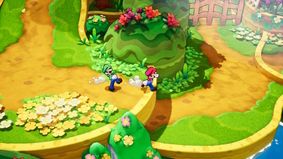 In order to deepen its mechanics, Mario & Luigi: The Brotherly Epic introduces the system of “takes”, passive bonuses that can be exchanged for free in combat without consuming any action. These sockets have a limited number of uses, but regenerate passively when exhausted, and allow to create some interesting combos. It would be really good if Acquire had not decided to introduce this system around eight hours after the start of the adventure, out of around thirty hours in total. Same observation with the brother attacks which are delivered in dribs and drabs. If the combat system is intelligent, the adventure drags on so long, with so much filling that it looks like a stuffed pillow, that the repetitiveness proves boring. And it's not the few decent boss fights that manage to wake us up. Not to mention that to make catches, you have to revisit the islands already visited to look for resources indicated on our map… the pinnacle of the Fedex quest right down to crafting, since it's not even a question of re-exploring the environment to try to find raw materials.
In order to deepen its mechanics, Mario & Luigi: The Brotherly Epic introduces the system of “takes”, passive bonuses that can be exchanged for free in combat without consuming any action. These sockets have a limited number of uses, but regenerate passively when exhausted, and allow to create some interesting combos. It would be really good if Acquire had not decided to introduce this system around eight hours after the start of the adventure, out of around thirty hours in total. Same observation with the brother attacks which are delivered in dribs and drabs. If the combat system is intelligent, the adventure drags on so long, with so much filling that it looks like a stuffed pillow, that the repetitiveness proves boring. And it's not the few decent boss fights that manage to wake us up. Not to mention that to make catches, you have to revisit the islands already visited to look for resources indicated on our map… the pinnacle of the Fedex quest right down to crafting, since it's not even a question of re-exploring the environment to try to find raw materials.
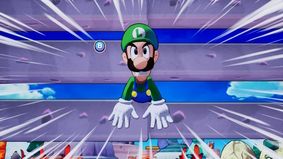 Despite these numerous grievances against Mario & Luigi: The Brotherly Epic, we must recognize that the Acquire title is a great graphic success, with a lot of animations which give a lot of personality to our protagonists – cleverly replacing the too often bloodless dialogues. Acquire makes a point of visualizing all our passive and active bonuses with relevant animations, which gives a beautiful visual richness to the fights, which remain clear in the action. It is however regrettable that the visual design of the main antagonists, except for the big bad who often broods in his corner, is frankly uninspired for our taste. There remains a handful of visual gags which hit the mark more often than the written jokes, if we were still reminded that the pen pales here compared to the pencils. The same goes for the music, which delivers a beautiful farandole of orchestral jazz pieces throughout the islands crossed. Nintendo has not lost control of the composition.
Despite these numerous grievances against Mario & Luigi: The Brotherly Epic, we must recognize that the Acquire title is a great graphic success, with a lot of animations which give a lot of personality to our protagonists – cleverly replacing the too often bloodless dialogues. Acquire makes a point of visualizing all our passive and active bonuses with relevant animations, which gives a beautiful visual richness to the fights, which remain clear in the action. It is however regrettable that the visual design of the main antagonists, except for the big bad who often broods in his corner, is frankly uninspired for our taste. There remains a handful of visual gags which hit the mark more often than the written jokes, if we were still reminded that the pen pales here compared to the pencils. The same goes for the music, which delivers a beautiful farandole of orchestral jazz pieces throughout the islands crossed. Nintendo has not lost control of the composition.

